1lumen selects and reviews products personally. We may earn affiliate commissions through our links, which help support our testing.
Noctigon DM11 Review
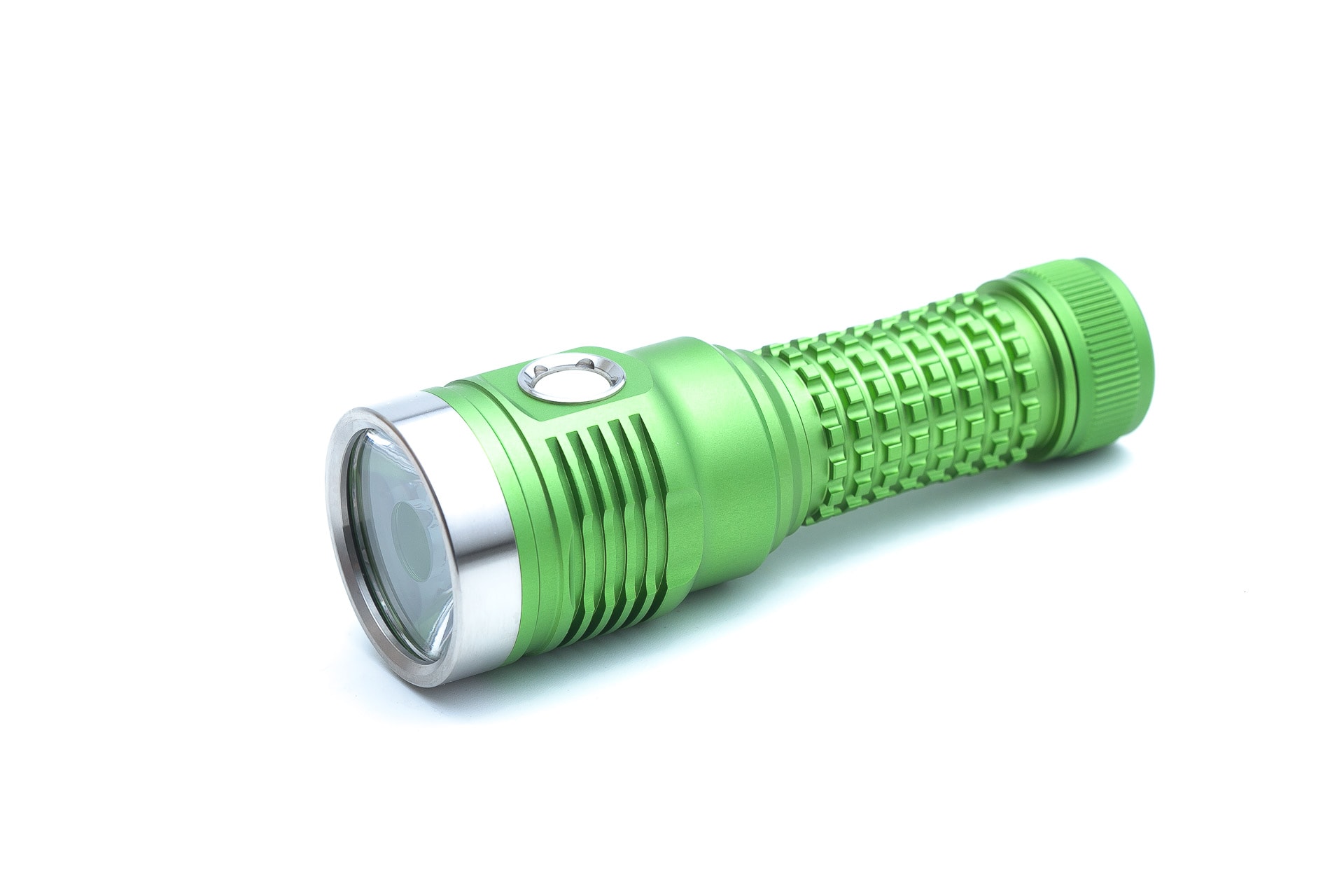
Noctigon DM11 specifications
| Brand/model | Noctigon DM11 |
|---|---|
| LED | Luminus SFT-40 |
| Max. Lumens | 1,800 lm |
| Max. Beam intensity | 130,000 cd |
| Battery config. | 1*21700 |
| Onboard charging | none |
| Modes | Many (Anduril 2) |
| Blinkies | Many |
| Reflector | TIR |
| Waterproof | IP67 |
| Review date | February 2022 |
Introduction:
Noctigon is another brand that is really popular in the flashlight community, but nobody outside it, has ever heard of it. Noctigon is another ‘Hank brand’ from intl-outdoor.com, besides Emisar. Hank is the owner of the store and builds interesting lights, highly focused on flashlight enthusiasts.
Some of the differences between a regular flashlight, and a ‘Hank light’ are the following:
- High customizable when ordering
- Many LED choices, different brands of LEDs, and even different color temperatures per LED. Sometimes as many as 10 different LED choices. Mainstream brands don’t have as many choices
- Anduril firmware with a gazillion features. Mainstream brands don’t have this, because of the complexity and user errors/customer support.
- Different body colors. Some other brands have this as well, but only on a small selection of their lineup.
- Optional magnet for in the tailcap. Mainstream brands don’t offer this as an option.
- Back light color of switch. You can even select the color of the backlight of the switch.
- All parts are accessible and no glue is used. Mainstream brands add glue to keep you out.
- Optional accessories like shiny bezels, different optics, different size batttery tubes, and even trit slots for in your tail cap.
Not all these options are available for every flashlight he offers, but you can email Hank personally and ask him for something special, that’s not even offered in his store.
So, while doing this review, I have to keep in mind this light is mainly for flashaholics.
Package quality.
Hank’s prices are relatively budget-friendly. They are not as cheap as Sofirn or Convoy, but also not premium like Surefire or Streamlight. Lower prices also translate into simpler packaging and accessories and Hank sends his flashlights in relatively simple cardboard boxes with few accessories. But that’s not a problem, because if there is anything wrong with your light, he will help you out!
- The flashlight: Noctigon DM11
- 2 O-rings
There’s no manual, or pocket clip included.
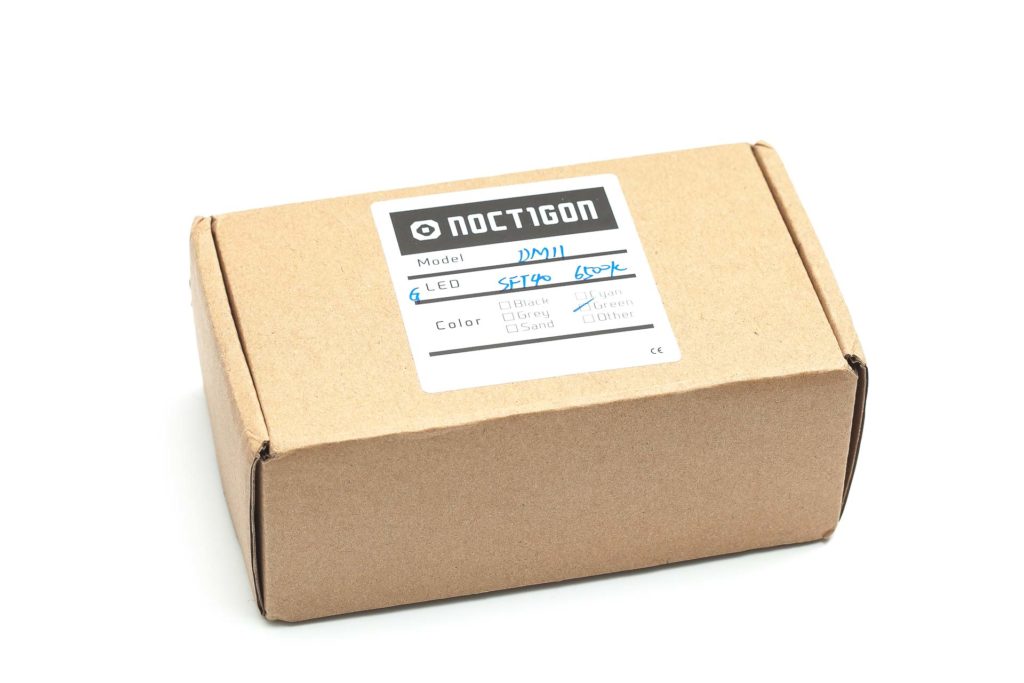
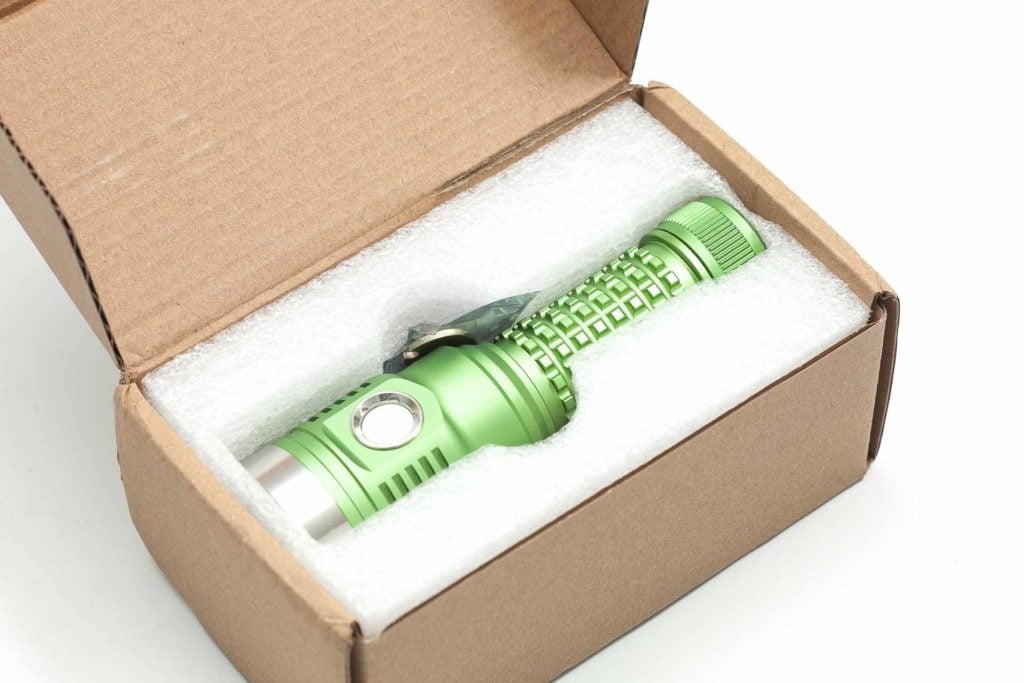
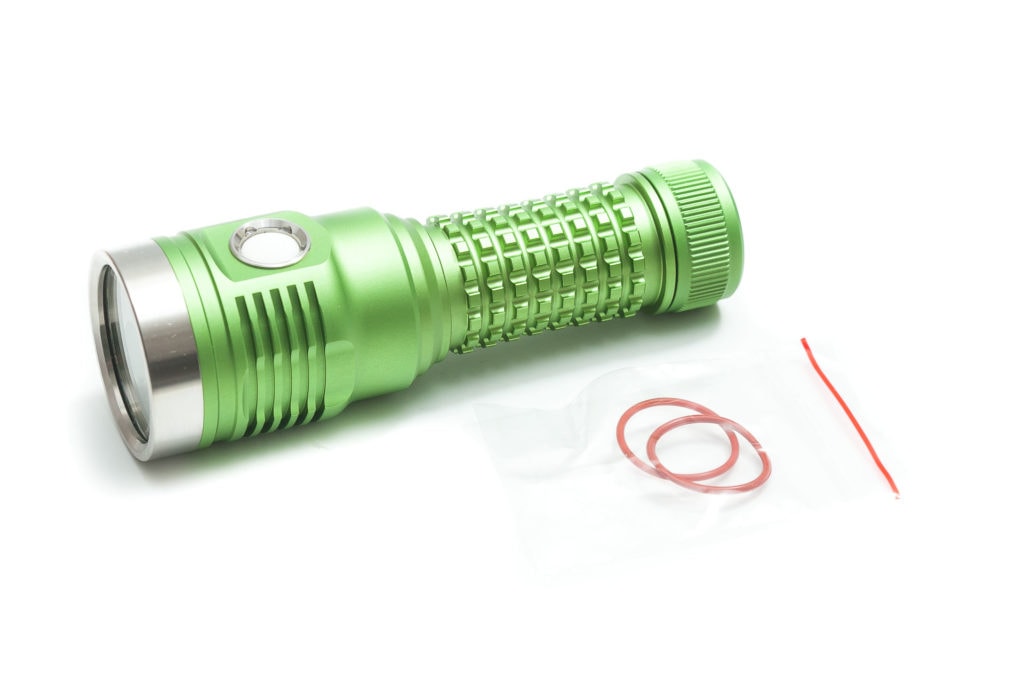
Flashlight in use
This particular light is owned by many people in the flashlight community. And there’s a mix of positive, but also a large majority of negative views on the knurling of the DM11. The knurling on the battery tube is really rough, and a bit unusual. I personally haven’t made up my mind yet, whether I like it or don’t like it.
My first impression of the knurling was quite positive. It’s rough, but I think I prefer something rougher than smooth and slippery. But what I did notice is the little odd ratio between the size of the head and battery tube. At first, I thought I had received a 18650 battery tube. The head is so large compared to the body, that it looks a little weird. I assume there will soon be an optional 26650 or 26800 battery tube, because that should easily fit.
But handling itself doesn’t feel unnatural, and manipulating the switch with my thumb is no problem.
It’s an electronic side switch that is recessed deep enough to make it more difficult to activate by accident. Fortunately, there is a lockout option built into the firmware that makes it even more difficult to activate accidentally.
At the same time, the switch might be a bit difficult to use with hand gloves.
I saw some people talking about an included pocket clip, but mine didn’t have one. And even though I don’t personally use pocket clips for their intended purpose, I like to use them sometimes for the extra grip (which is unnecessary on the DM11) or as an anti-roll feature.
Something else I was missing was a lanyard attachment point. Other models like the D4 v2 or the D4S v2 have a tailcap with a lanyard attachment point. I don’t know the reason for leaving that one out, but some people like using lanyards.
The tailcap is flat, so it’s easy to make it tailstand.

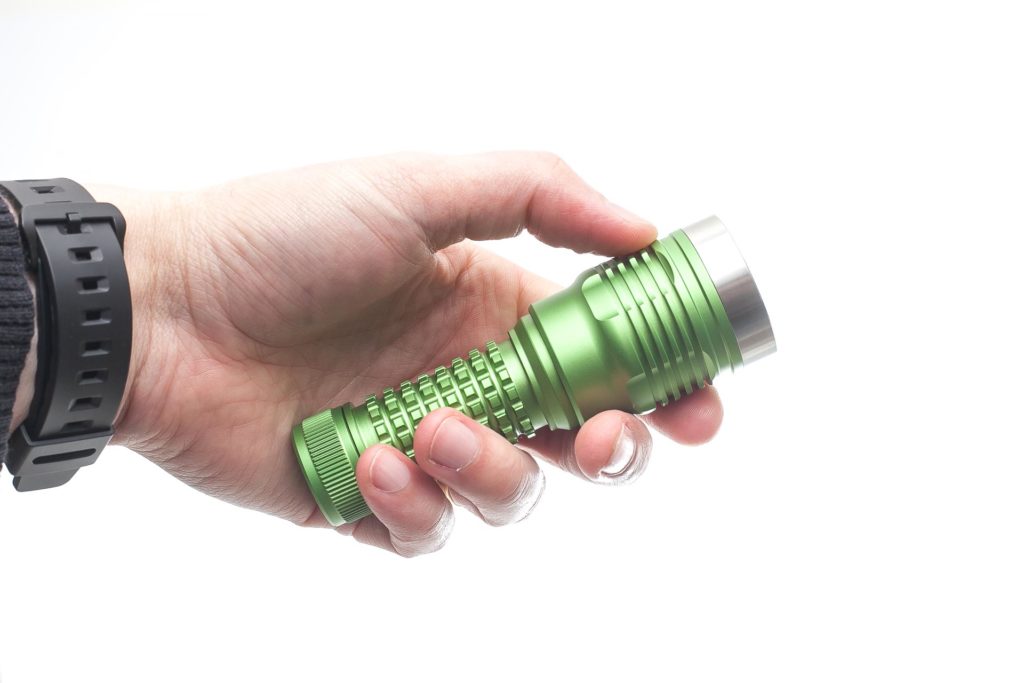
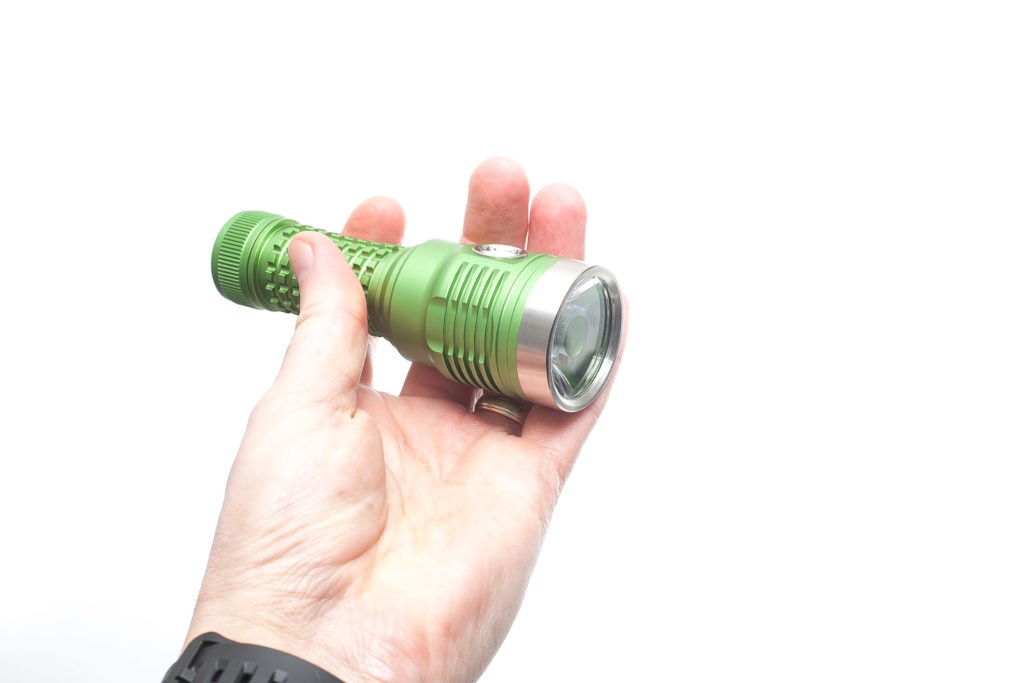
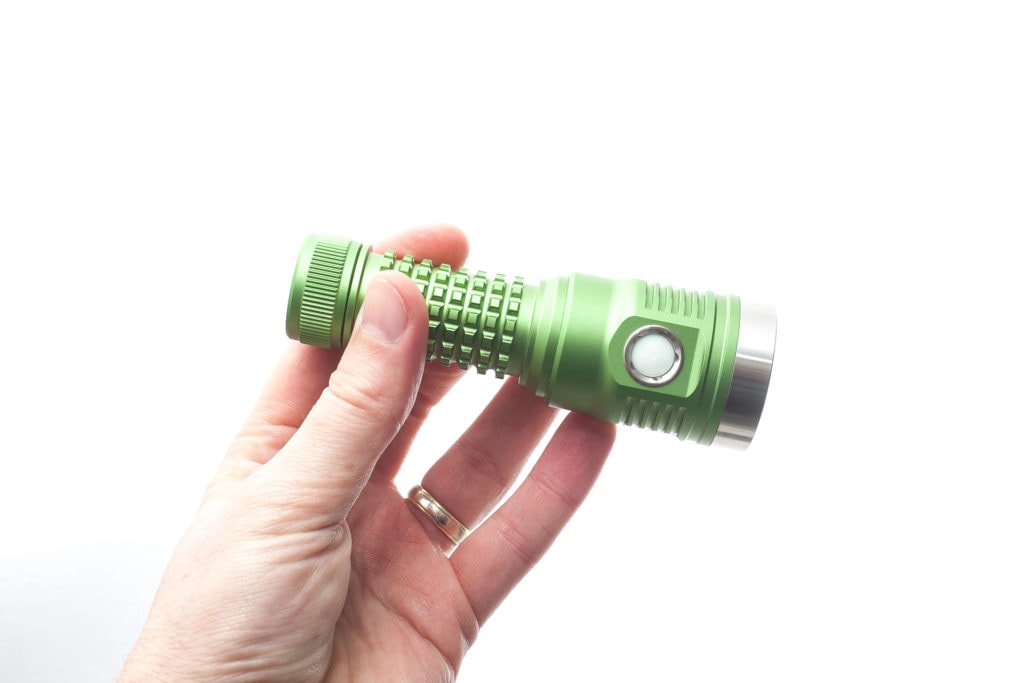
Build Quality, and Warranty
Noctigon and Emisar flashlights are built with great care and have excellent customer service. Since I have enough black flashlights, I choose an unusual color when ordering, namely green.
The anodization looks pretty good, and I can only see a few very small imperfections in the machining. Nothing to complain about though.
One more thing I was missing is a model name/product name on the flashlight itself. I can imagine forgetting the product name after a few years, and not being able to find this flashlight back. Fortunately, the logo (Noctigon) is printed on the tailcap, but there is no mention of DM11 anywhere on the light.
Threads on both end of the battery tube are lubed, and square cut. The threads are nice thick, so you won’t be able to do some cross-threading. And inside the tailcap you can find a single spring, on a board, probably glued into the tailcap.
I’m not sure of any official warranty, but from what I read, Hank is usually pretty cool about this.
btw some of the pictures below are just a bit greener than in person.
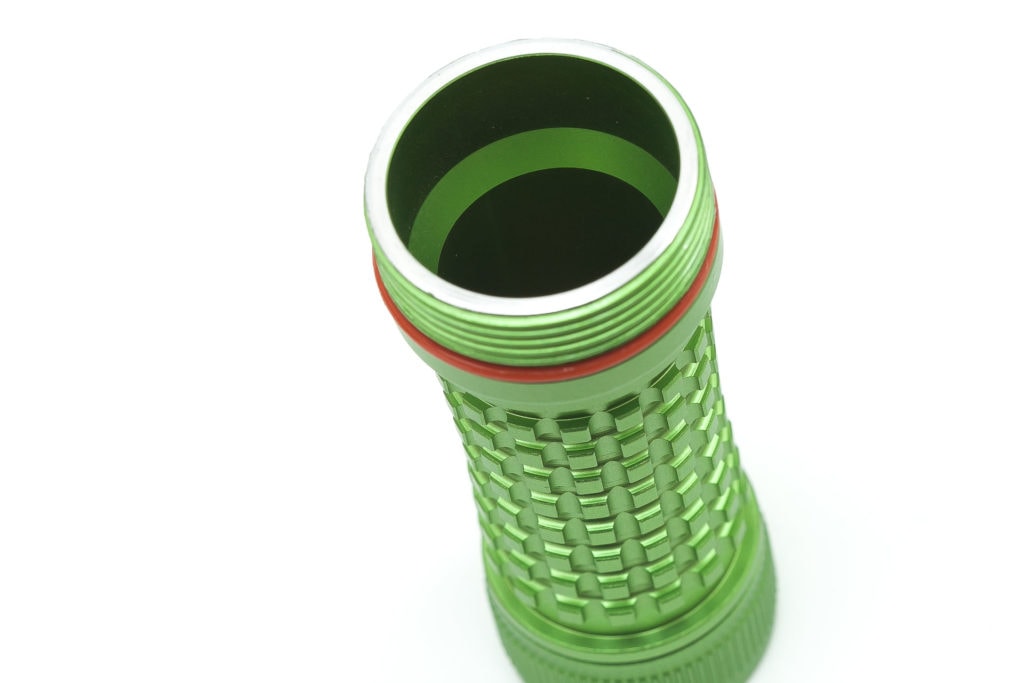
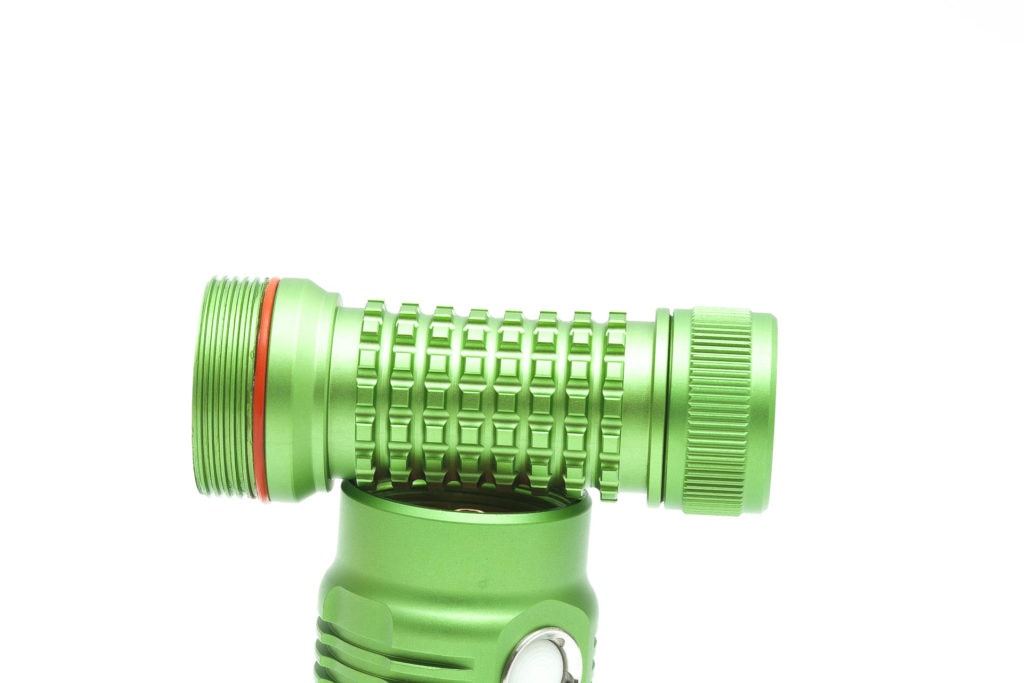
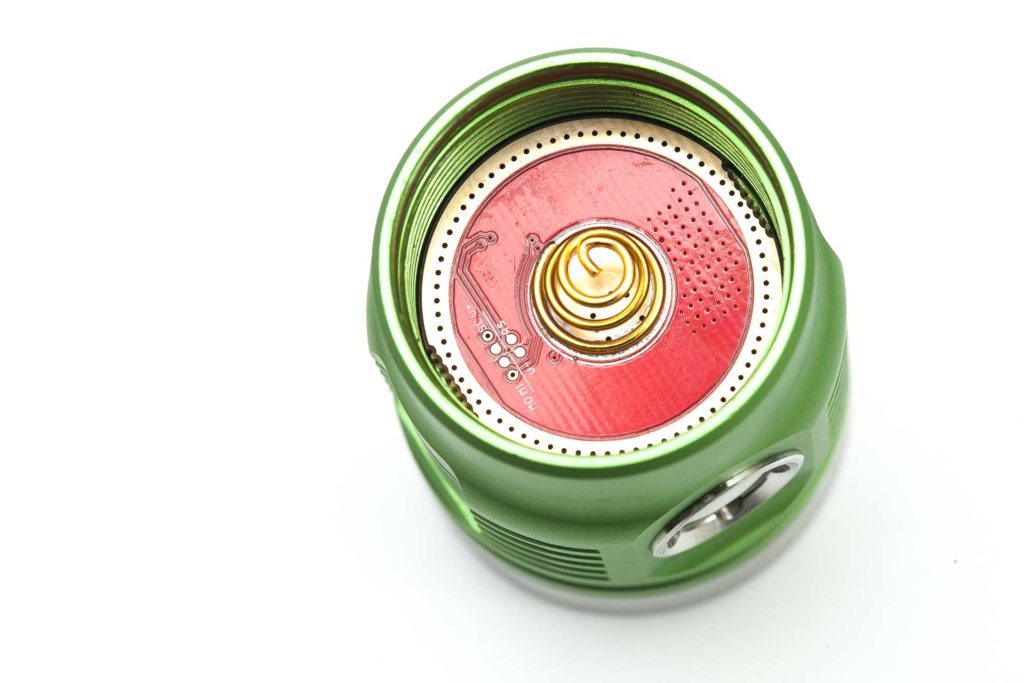
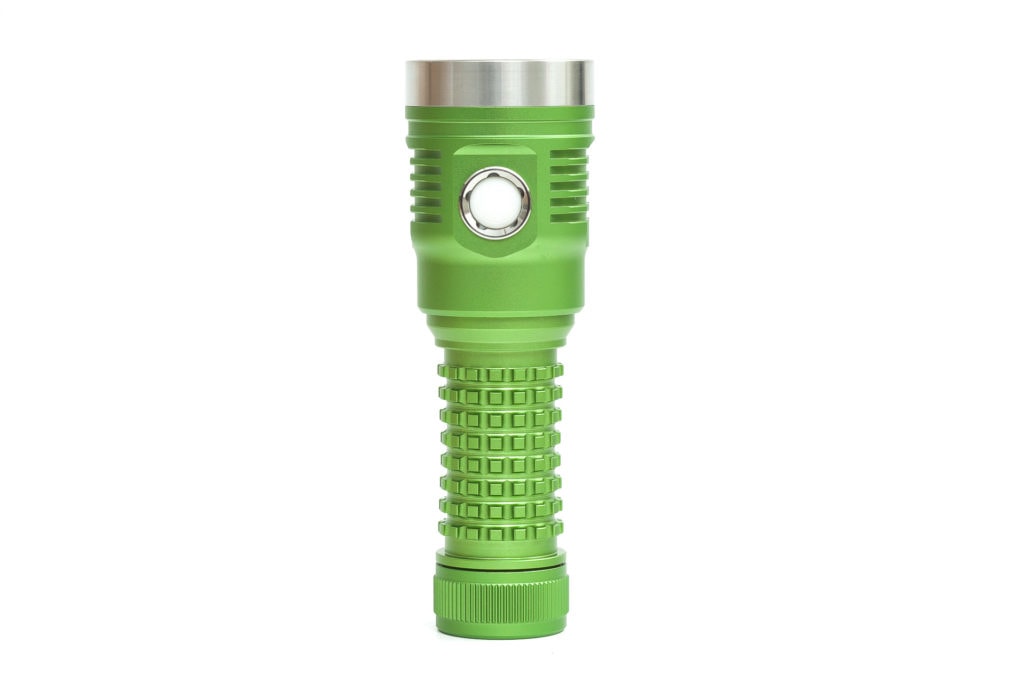
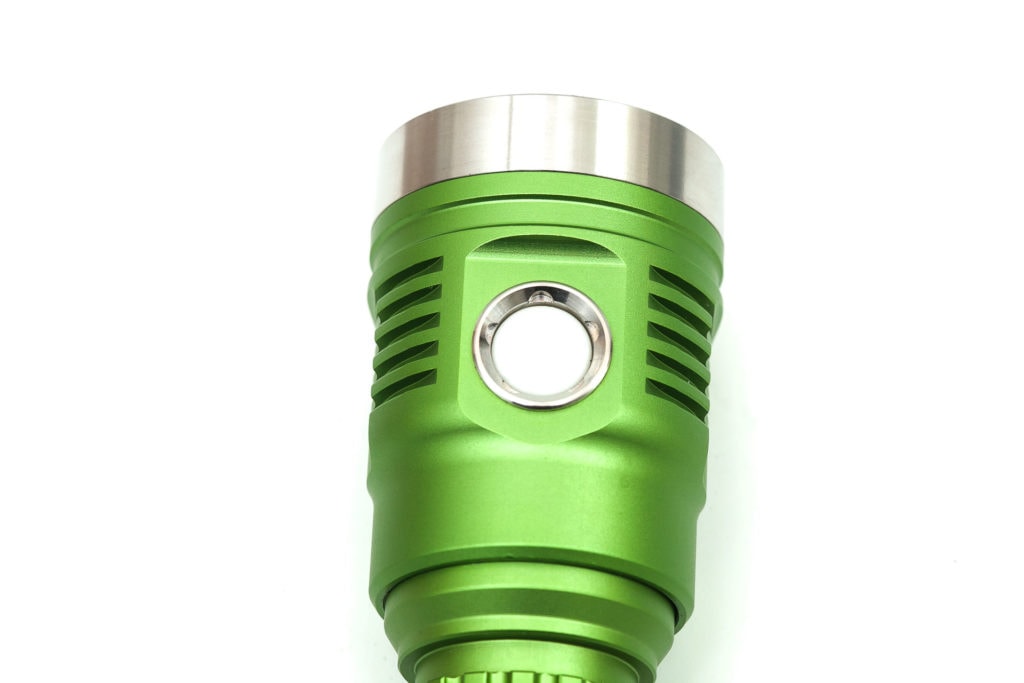
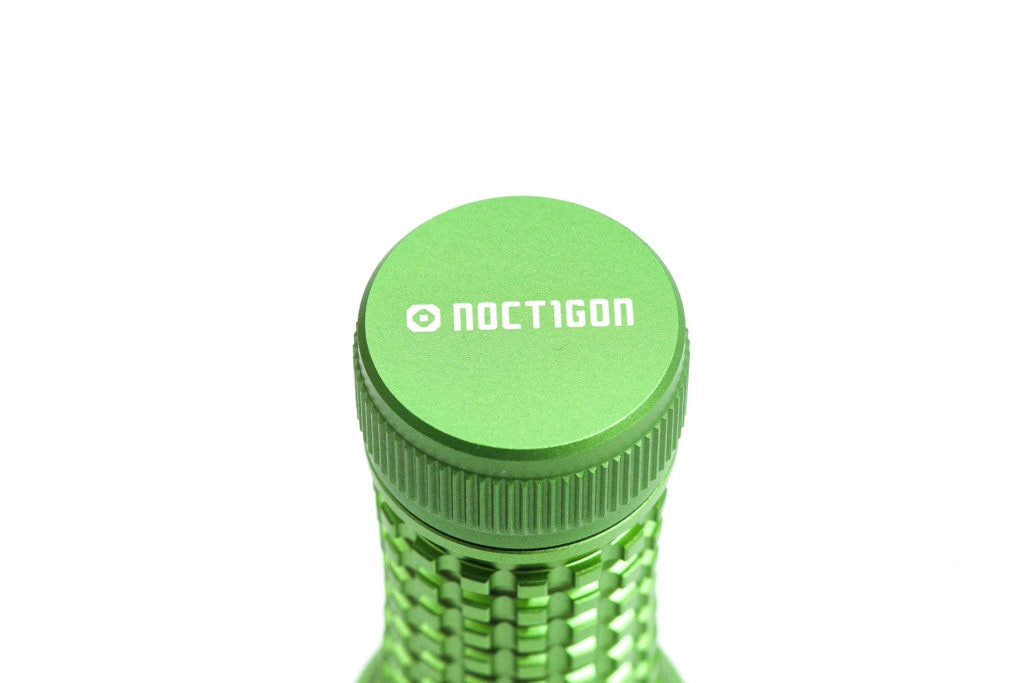
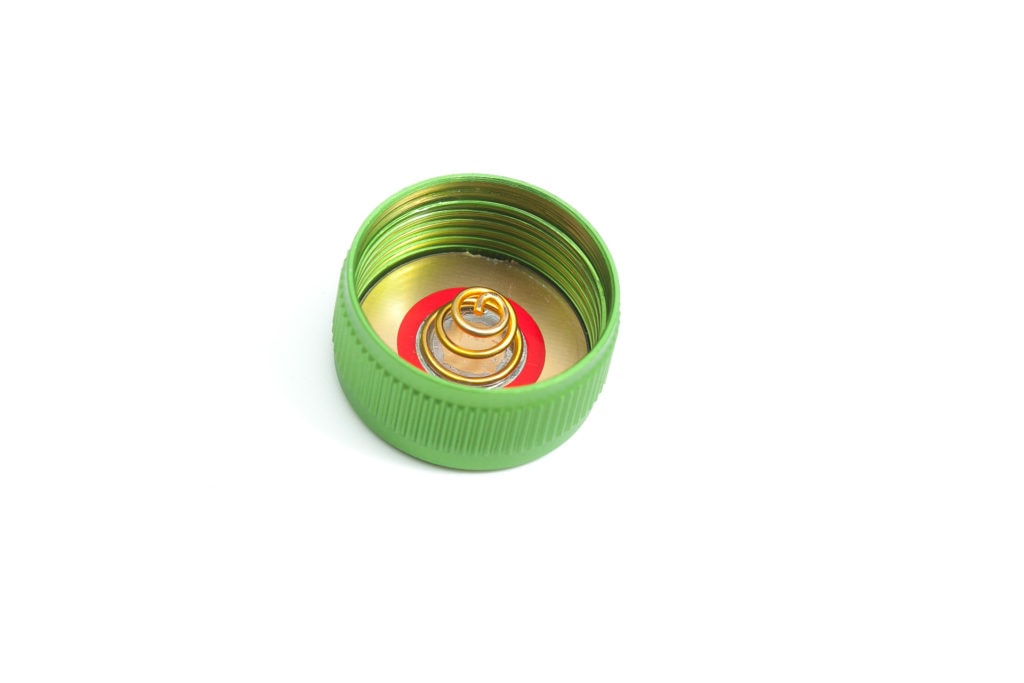
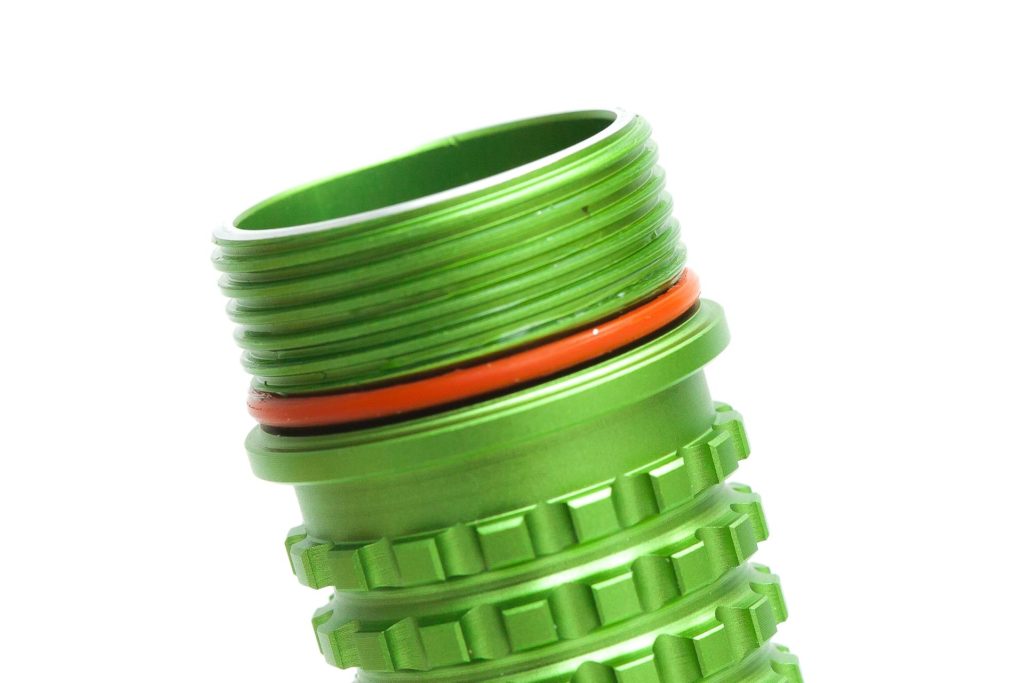
LED, Lens, Bezel, Beam, and Reflector
Ok, if there is 1 manufacturer to give you the best choices, it’s certainly Noctigon/Emisar. Hank has the most choices of LEDs of all the manufacturers. Here is the list of options, at the time of reviewing this light:
- Osram W1 6000K
- Osram W2 6000K
- SST-20 6500K
- SST-20 5000K
- SST-20 4000K (high CRI)
- SST-20 2700K (high CRI)
- SST-40 5000K
- SST-40 6500K
- XP-L Hi V3 1A 6500K
- XP-L Hi V2 5D 4000K
- XP-L Hi U4 8A 2850K
- Osram W1 amber
- Osram W1 green
- Osram W2 deep blue
- SST-20 deep red
- Nichia B35AM R9080 2700K
- Nichia B35AM R9080 3000K
- Nichia B35AM R9080 3500K
- Nichia B35AM R9080 4000K
- Nichia B35AM R9080 4500K
- Nichia B35AM R9080 5000K
- Nichia B35AM R9080 5700K
- XHP35 Hi 4000K
- SFT-40 6500K
Yup, that 24 choices. Probably the most ever available for a specific flashlight. For every tint snob there is something available.
I choose the SFT-40 6500K, because I wanted something of a balance between throw and power. The Osram W1 is way lower in power, but more throw. So I hoped the SFT-40 to be a nice in-between.
With the included reflector, you get a nice-sized hotspot and a little bit of spill.
Using the Opple Light Master III, I got the following numbers. Measurement about 10 seconds after turn on, in one of the highest modes. Distance about 1.5- 2 meters
- CCT: 6638
- CRI (Ra): 69.6
- DUV: 0.0004
That’s a pretty cold beam, low CRI, and DUV just above the BBL (and therefore almost no visible green tint).
You can also choose the color of the light inside the switch. You can choose the following:
- Cool white
- Warm white
- Cyan
- Green
- Amber
- Red
Below are 3 different AUX colors pictured. There are more colors, I just wanted to show a few.
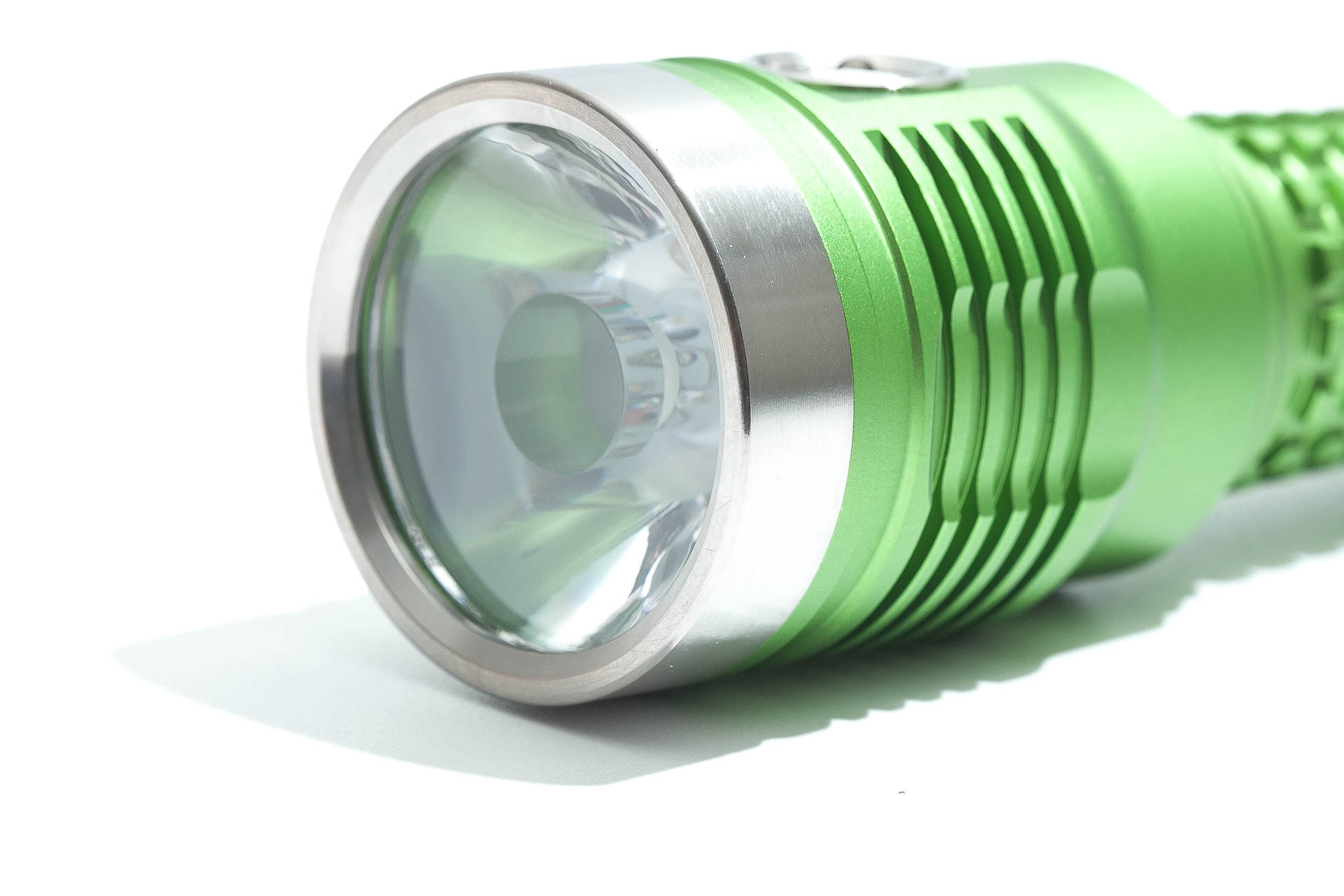
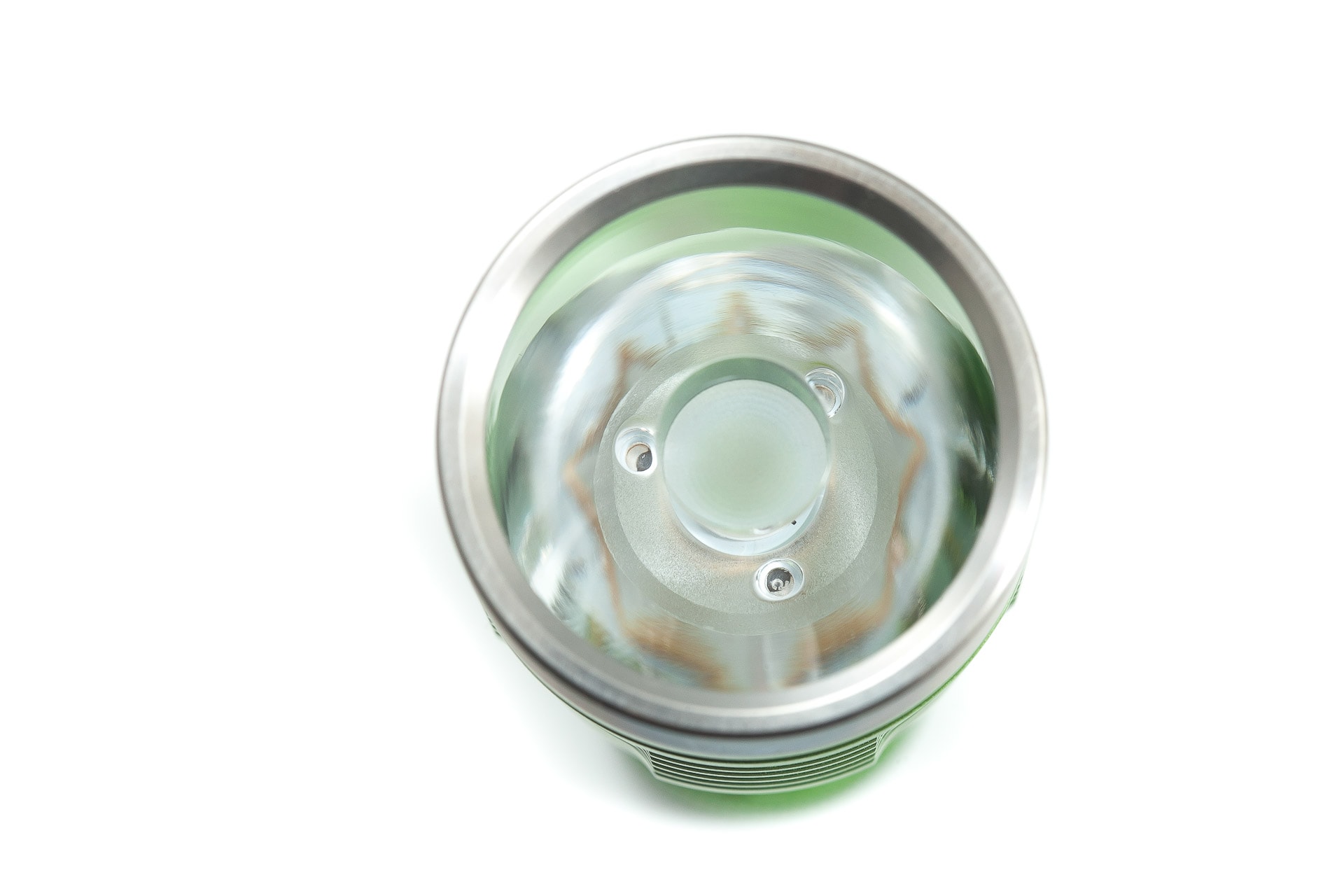
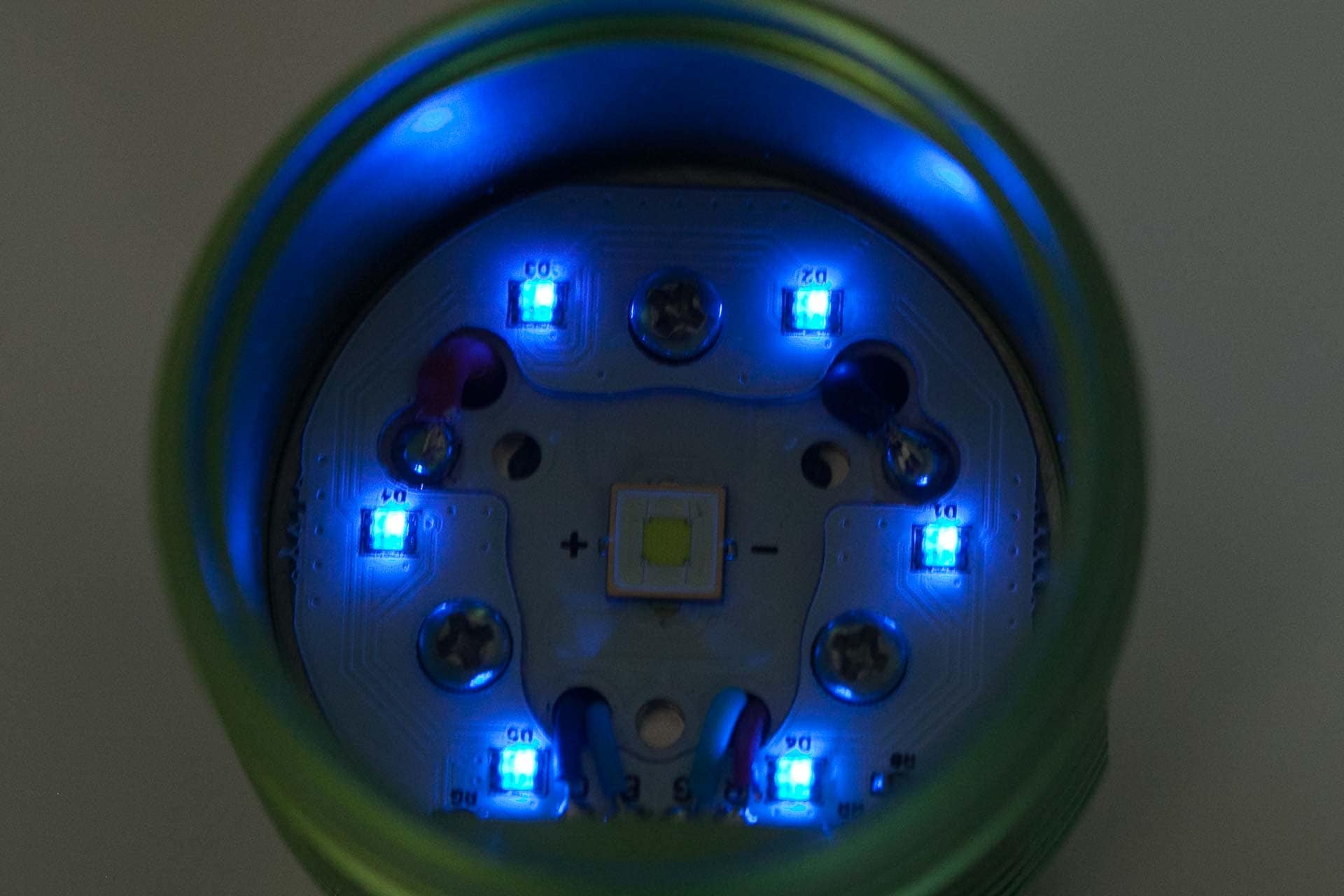
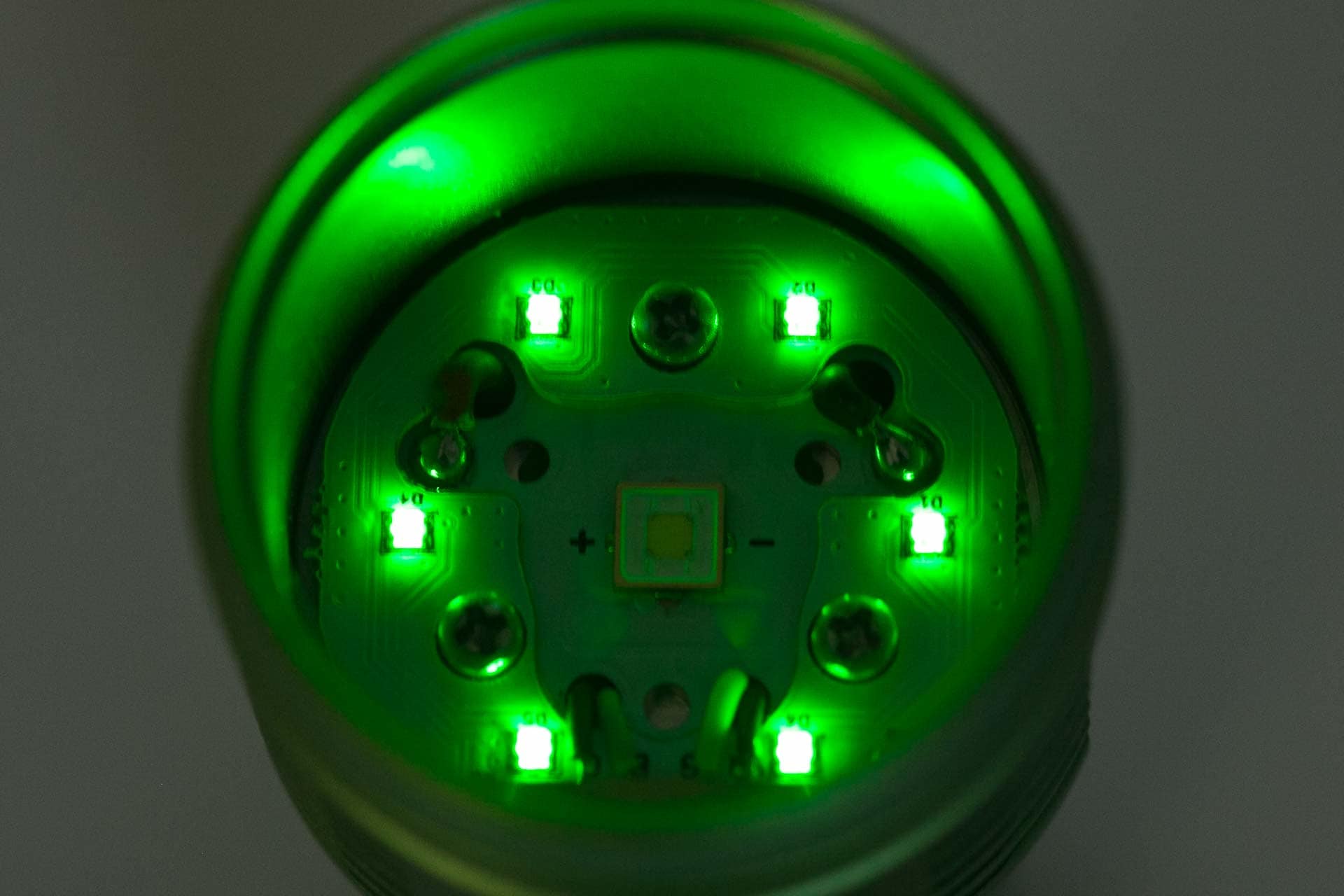

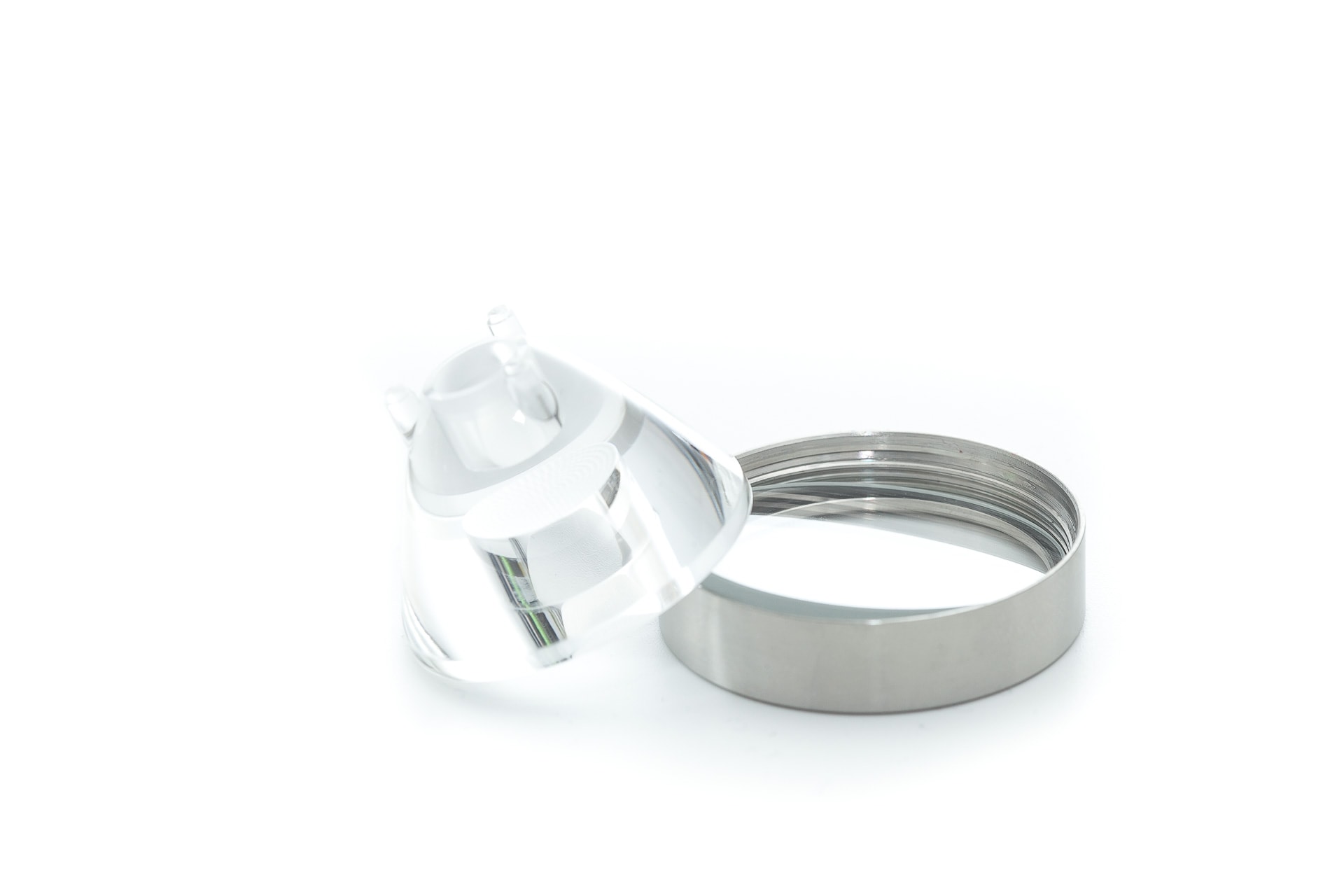
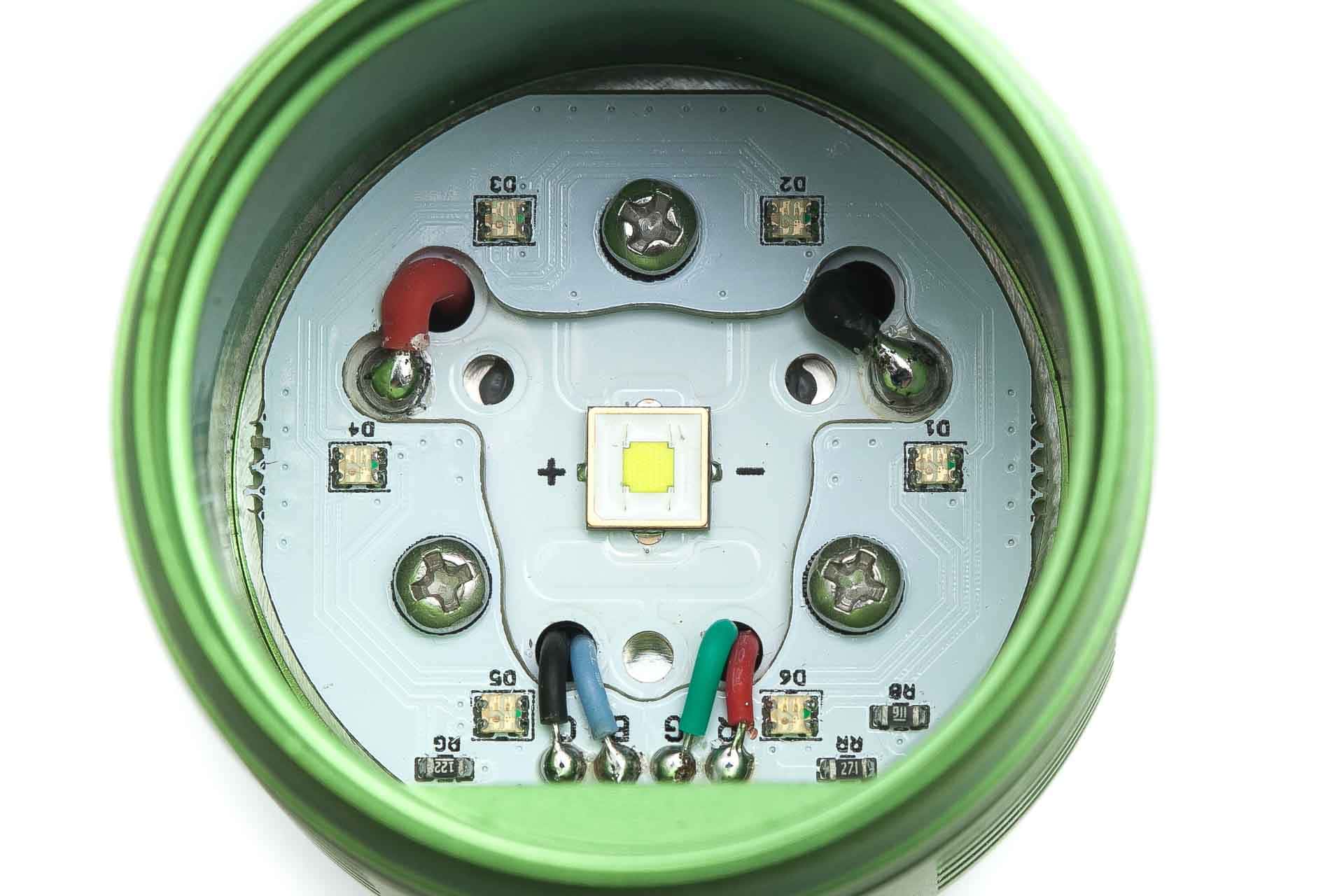
Dimensions and size comparison
- Length: 121 mm / 4.77 ”
- Head diameter: 40 mm / 1.577 ”
- Tailcap diameter: 29 mm / 1.14 ”
Weight:
- Empty: 126.6 g / 4.47 oz
- With Samsung 50G battery: 196.2 g / 6.92 oz
Thrower flashlights comparison
Size compared to some of the best smaller long-range flashlights
From left to right: Lumintop X1L, Manker MC12 II, Noctigon DM11, Lumintop GT Mini, NlightD T90, Boruit C8, Convoy C8.
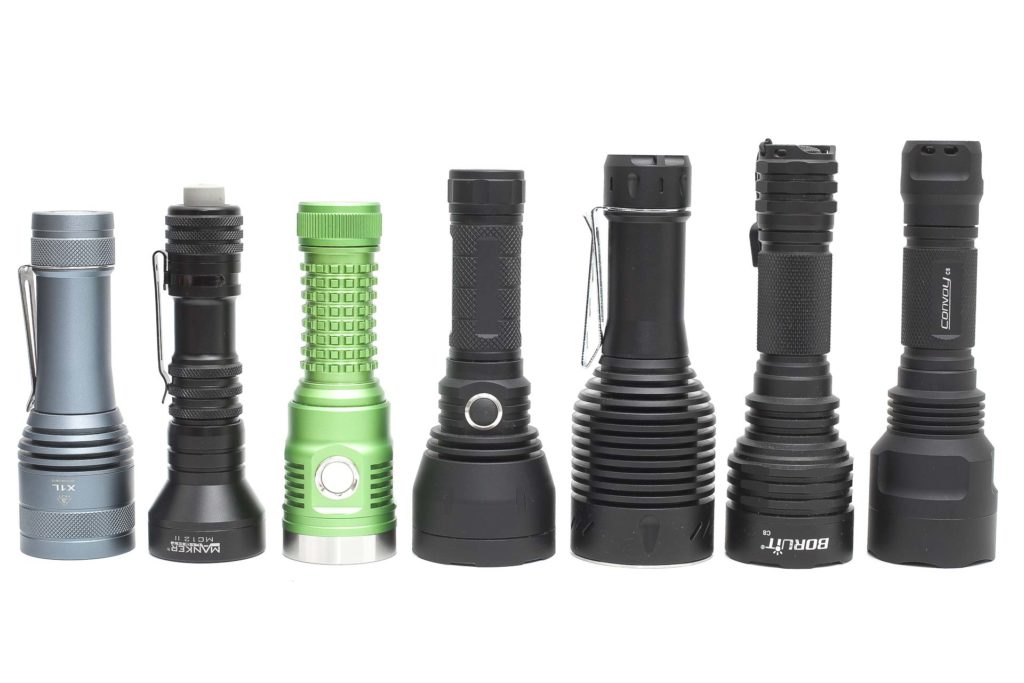
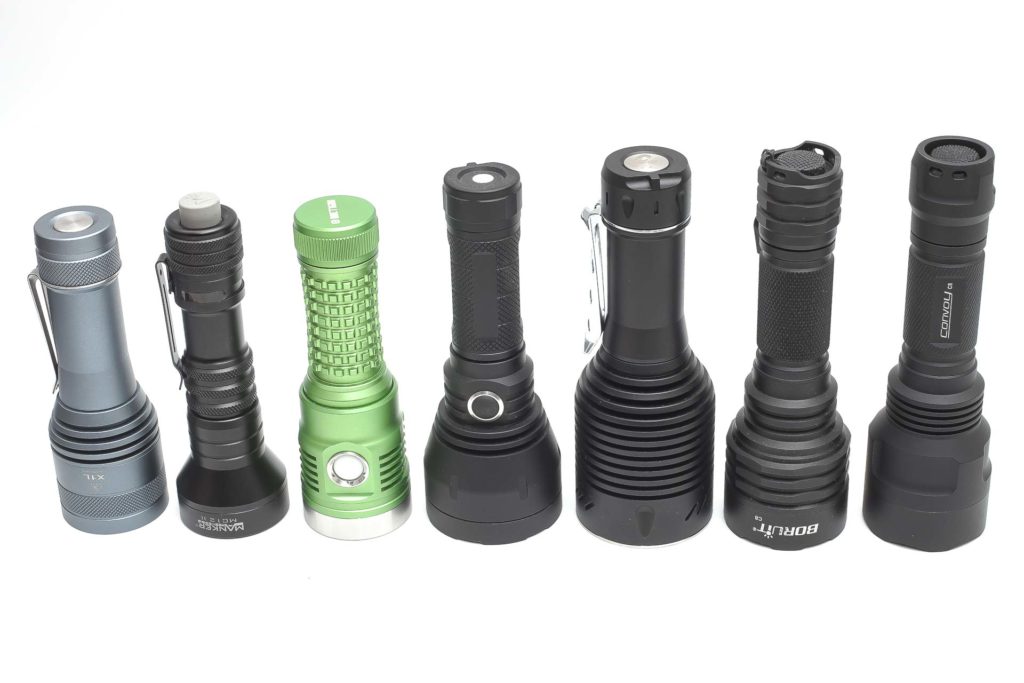
Driver & User Interface:
The DM11 uses the immensely popular (in the flashlight community) Anduril 2 firmware. This is a highly sophisticated firmware that some people like, and others hate. You need to decide for yourself whether this is useful firmware or not. I already made up my mind :–)
Anduril 2 User Interface
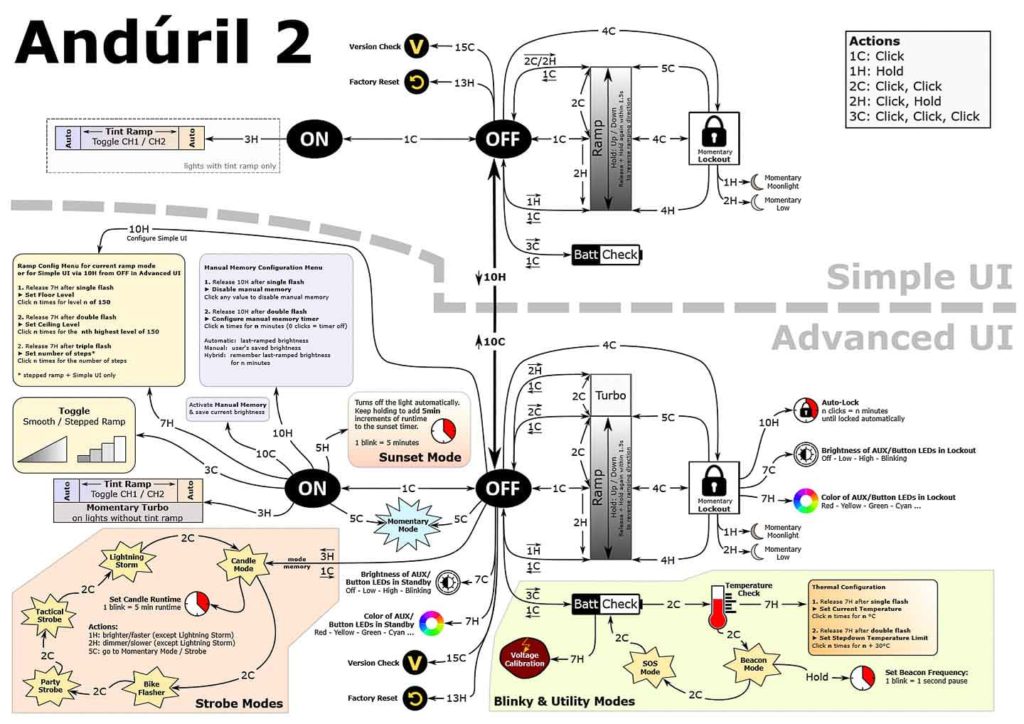
Here is another Anduril 2 image.
And by default, it uses the Simple UI… and here is the UI diagram:
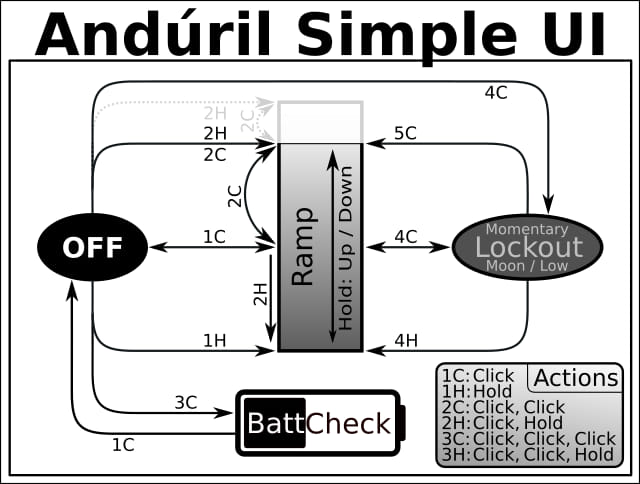
Anduril2 has two UI’s available: Simple and Advanced. The light came with the Simple UI enabled, and I think it’s kind of a misnomer because it’s still a little complicated for a first-time user. However, those familiar with the original will pick it up pretty quickly. Simple UI is missing some of the familiar features present in the original, namely the special blinky modes, temp check, and thermal configuration (those are present in the Advanced UI), and there’s no “muggle” mode either. You still get access to smooth ramping (stepped is, you guessed it, only available in Advanced UI), lockout, momentary high, battery check, and some useful lock/unlock modes.
The Advanced UI is appropriately named because it’s, well, advanced and there’s a plethora of options and configurations available. There’s probably way more features than the average user would ever dip into, but it’s nice to know you can tweak things like the voltage sensor calibration for batt check, AUX LED settings, and even configure the auto-lock. I found this to be a pretty useful feature that enables the light to automatically turn off after a certain amount of time if the light is accidentally activated.
Modes: Simple and Advanced UI both have many standard and blinky modes available, but the main modes are stepped and smooth ramping, but stepped ramping is only available in Advanced UI, and smooth is enabled in both Simple and Advanced.
Switch to Advanced UI from Simple: 10 clicks, but hold on the 10th click
From OFF:
- Press and hold: Turns on in either smooth or stepped ramp (depending on which mode is enabled)
- Single click: Turn on in last mode (step or ramp state-again depends on which mode)
- Double click: Ramp ceiling/turbo
- Triple click: Battery check (in Simple and Advanced UI)
- Triple click and hold: Special strobe modes-remembers last used (in Advanced UI)
- Quad click: Lockout mode. In lockout mode you have different options available:
- 1 click: momentary moon (bottom of ramp)
- 2 clicks: momentary (higher floor)
- 4 clicks: turns on in ramp mode
- 4 clicks with a hold: on in ramp mode, lowest/floor
- 5 clicks with a hold: on in ramp mode, highest/ceiling
- 10 clicks with a hold: configure the lock timeout threshold (in Advanced UI only). This is a new feature for Anduril2, it allows you to set a timeout to the lock, where the light will lock after a pre-set elapsed time.
From ON:
- Press and hold: Ramp up (depending on the mode)
- Single click: Turn off
- Double click: Ramp ceiling/turbo
- Double click and hold: Ramp down
- Triple click: Toggle between smooth and stepped ramping (in Advanced UI only)
- Quad click: Lockout mode (see above for the lockout options)
Mode memory:
- Yes, memorizes last on state setting either smooth or stepped ramping, but does not remember blinkies
Low voltage warning:
- Yes, when in operation, the light steps down brightness gradually until turning off when the cell is around 2.9 volts.
Strobe/blinkies
- Yes, many! The blinkies are accessible from off with 3H (click click click-hold) in ADVANCED UI only. You switch between strobe modes with 2 clicks:
- Candle mode
- Bike flasher
- Party strobe
- Tactical strobe
- Lightning storm
Lock-out mode:
- Yes. In Simple or Advanced UI, lockout is accessed by 4 clicks from on or off. 4 clicks to unlock. The lockout enables momentary operation in the moon mode, however, 2H (click click-hold) enables low mode. There are other lockout modes available (see the diagram).
Temp check and thermal calibration mode
- In the first version, you could do both the ambient temperature sensor calibration and thermal ceiling at the same time, but in Anduril2, it’s a little different. When in temp check, click 7 times and hold on the 7th to enter the thermal configuration. To configure the ambient temp, wait for the first flash and then set the ambient, but once you’ve done that, you need to go back to the temp check and click 7 times, hold on the 7th, this time, don’t let off the button. Wait for the 2nd blink, and then you can set the thermal ceiling.
PWM
- There’s PWM visible via camera, but when pointing the light at a fan and ramping up and down, there’s not a noticeable change in “blade speed” as you might get with some other lights, so it’s not hugely visible to the eye.
Batteries & Charging
Currently, there is only 1 battery tube available, and that’s for 21700 batteries. Long protected batteries don’t fit!
Performance
Lumen measurements:
All output numbers are relative to my homemade Integrating Sphere. It is set up with an Extech SDL400 Lux Meter for measurements including a Kenko PRO1D ND-16 filter. The base measurement is done with a Convoy S2+ that has been tested at 255 lumens.
For Amp readings, I use a Fluke 77III DMM. For higher amps I now use a Fluke 325 True RMS clamp meter. For microamps, I use a cheap DMM with an easy-to-use micro amp setting. It’s very possible that the Amps aren’t 100% correct, since it depends a lot on the probes I use. These are from standard Fluke probes.
All of my readings were taken from a fully-charged Samsung 50G. I measured the output manually at turn on, and after 30 seconds. The 10 minutes measurements are taken from the runtime graph.
| Mode | Amp at start | Specs | start | 30 sec | 10 minutes |
|---|---|---|---|---|---|
| 1/7 | 0.01 A | – | 0.63 lm | 1.26 lm | – |
| 2/7 | 0.04 A | – | 14 lm | 14 lm | – |
| 3/7 | 0.15 A | – | 62 lm | 62 lm | 62 lm |
| 4/7 | 0.46 A | – | 183 lm | 183 | 183 lm |
| 5/7 | 1.18 A | – | 429 lm | 429 lm | 421 lm |
| 6/7 | 2.54 A | – | 835 lm | 825 lm | 477 lm |
| 7/7 | 4.69 A | – | 1385 lm | 1215 lm | 461 lm |
| Turbo | 5.7 A | 1800 lm | 1971 lm | 1385 lm | 465 lm |
I was able to reach more than 1,800 lumens, but only at turn on. After 30 seconds it already dropped to below 1,400 lumens. Still not bad!
Parasitic drain:
- Ranging from 0.8mA to 1.3mA with AUX lights on, and switch backlight.
- 27µA with both AUX and switch light turned off. But every few (about every 9 seconds) seconds it will jump to about 0.2mA
Runtime:
The runtime test was done with the 50cm integrating sphere, including the Kenko Pro1D ND-16 filter and Extech SDL400 data logging Lux Meter.
I set it to stepped modes in order to have some reference. Default settings.
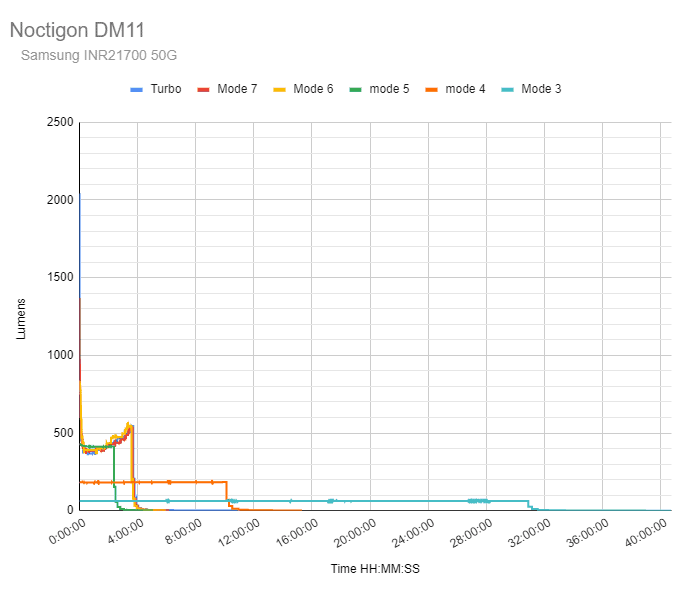

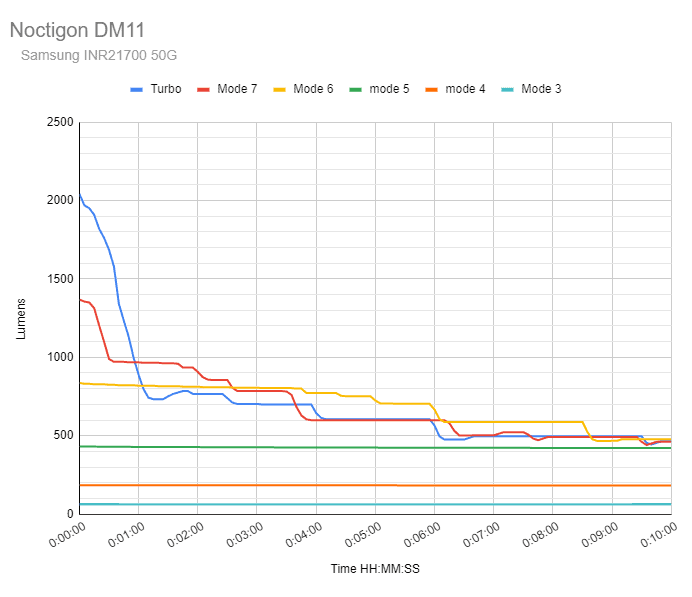
It’s too hard to really describe every runtime test because of the nature of Anduril firmware. You better look at the graphs yourself and make up your mind. The only strange behavior (besides the typical Anduril graph), is mode 5. I don’t understand why it is shorter than the 3 higher modes. So take that one with a grain of salt.
The light maintains a very low output for many hours, after every runtime test I did.
Throw Measurement
Measurements were taken outdoors at 20 meters with a professional Hagner E4-X Lux Meter.
| Specs | Cd measured | Throw in Meters | Throw in Yards |
|---|---|---|---|
| 130,000 cd | 86,000 cd | 587 meters | 641 |
Every time I review an Anduril light, I feel like I forgot something or didn’t measure the correct mode. Yes, I hate the firmware as a reviewer, lol. Just too many settings and adjustments that you can never really say what the best setting is for the review etc (temperature etc). When the specs show 130,000 cd, and I only measured 86,000 I start to doubt my measurements, because maybe I used simple UI without Turbo??? Probably.
So I tested it again, and now at 5 meters indoors, with my lux meter set to x100, and I measured 117kcd.. go figure. At least it’s not reaching the claimed 130,000 with a Samsung 50G battery.
Beamshots
For the following beamshots, I used a Canon EOS 5D Mk2 and a 50mm lens. Manual settings: ISO1600, 1/4sec , F4, 5000K
The shed is about 65 meters / 71 yards away, and the fence + trees are about 200 meters.
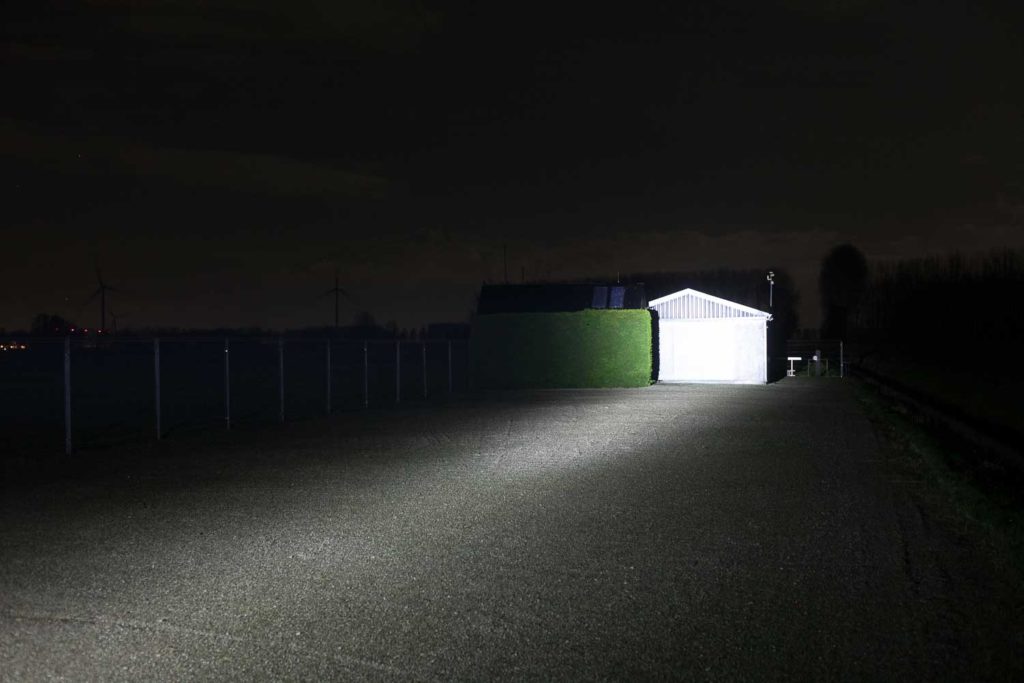
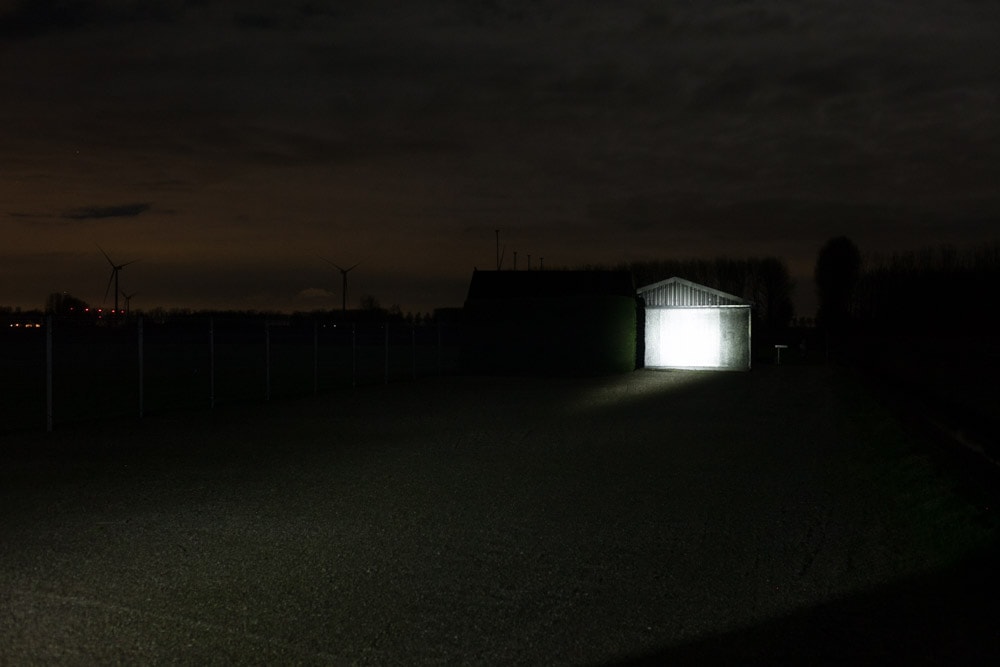
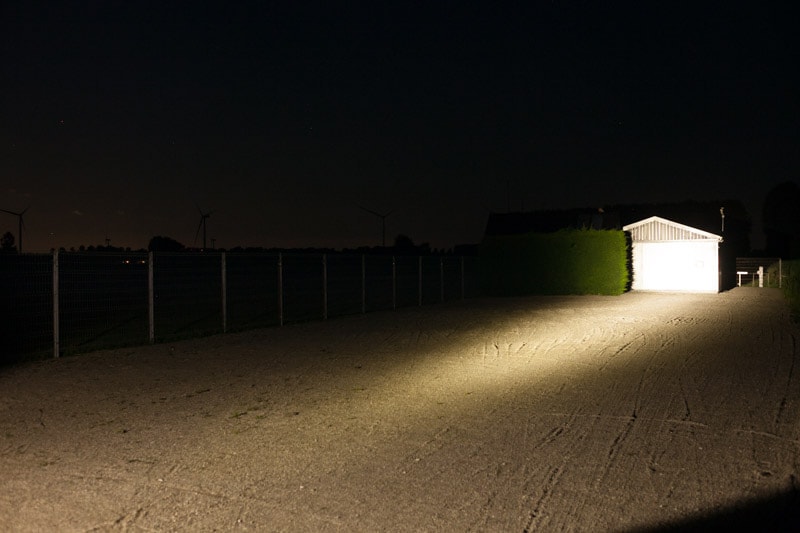
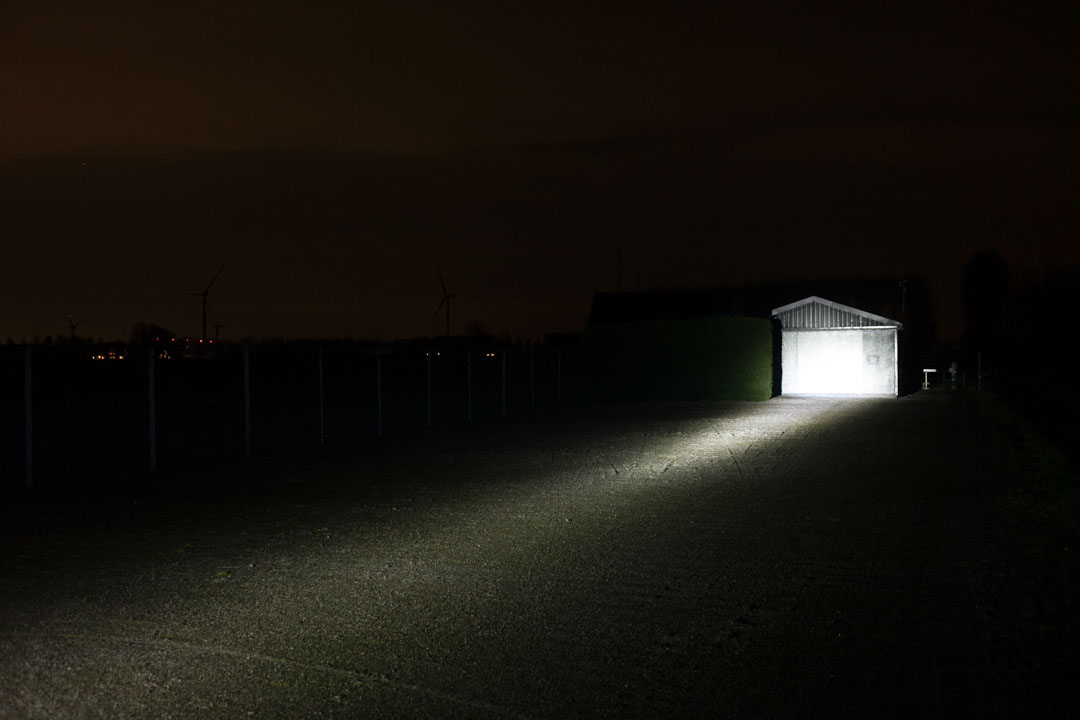
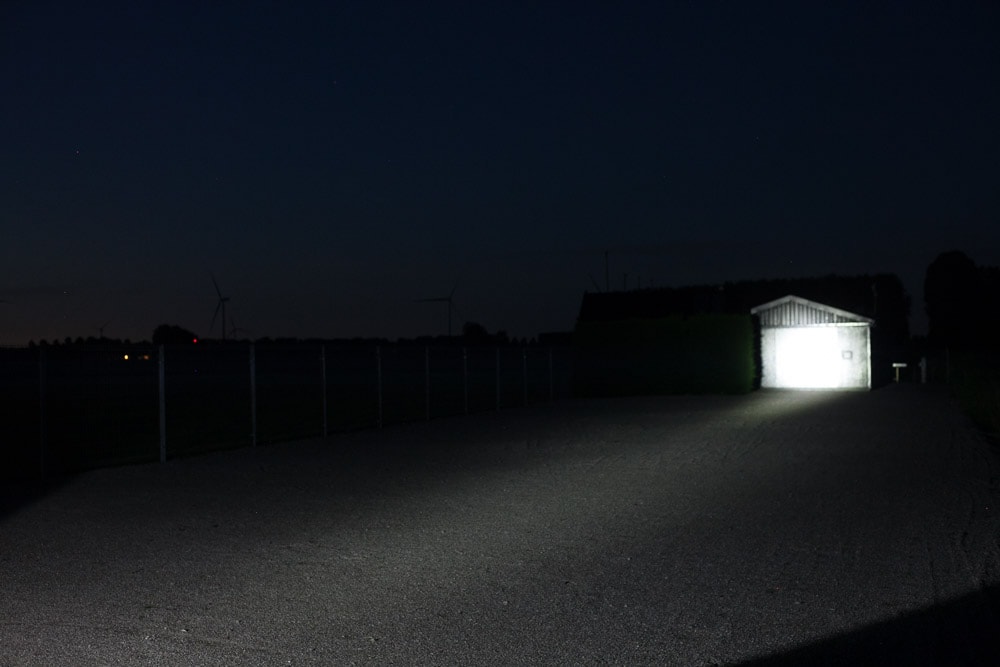
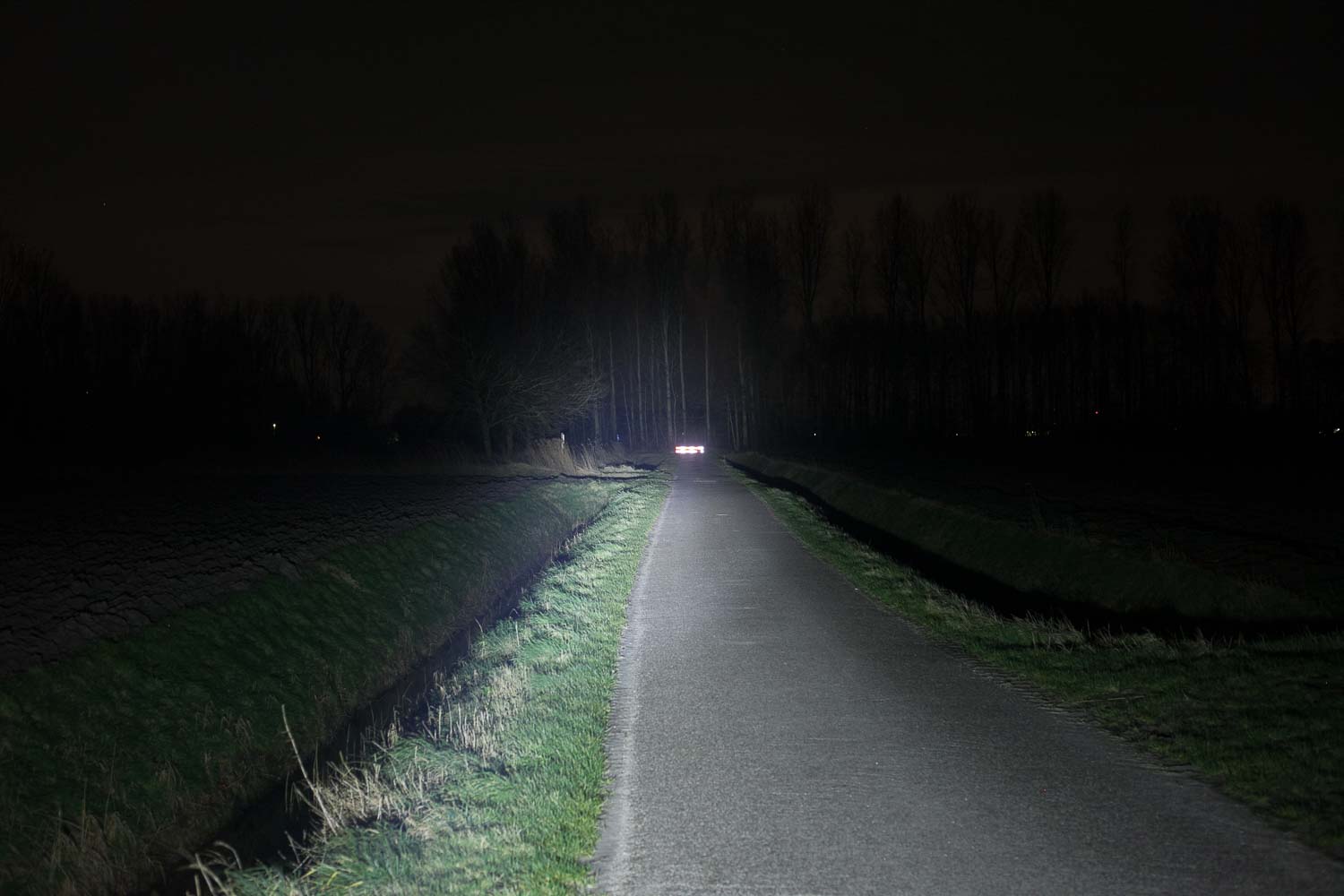
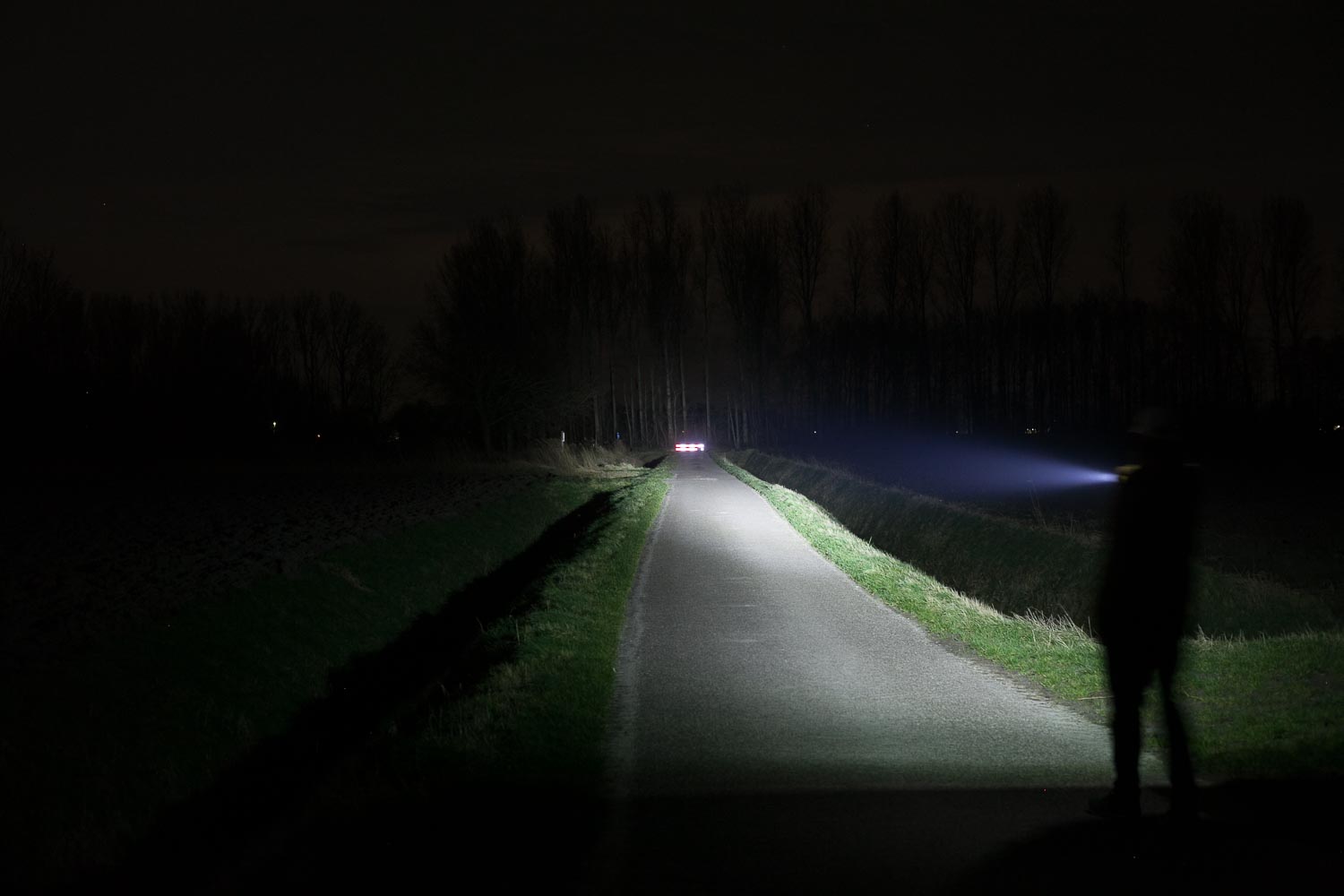
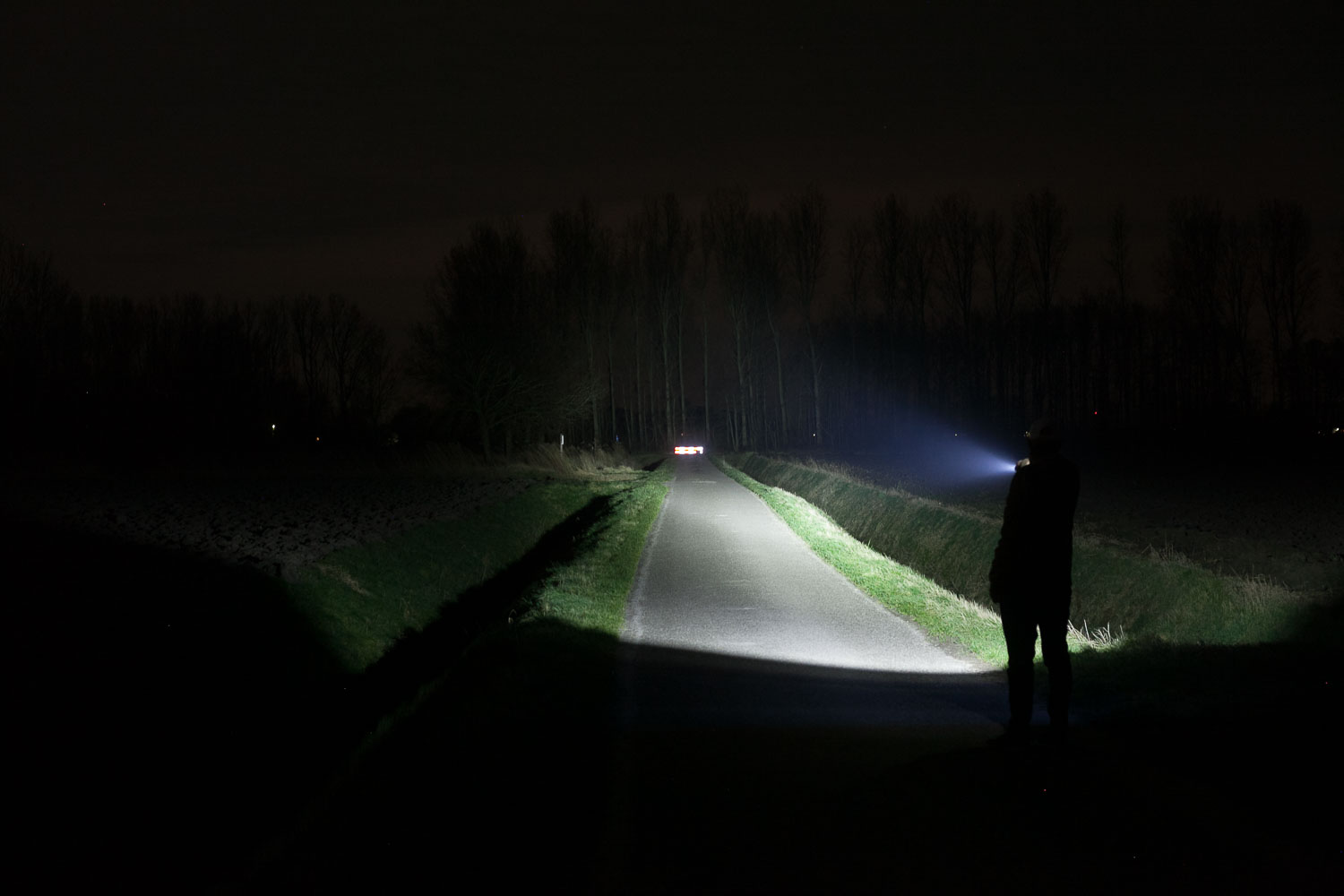

Disclaimer: I bought this flashlight with my own money. Nobody paid me to review this flashlight, nor have I been holding back on problems or defects.
Final Verdict
Pros
- Green anodization :–) with stainless steel bezel
- Extremely many options (Anduril 2) in firmware which can also be a con
- Many LED options
- Possible new battery tubes available soon
Cons
- Typical Anduril runtime graphs, but not as bad as the Anduril 1
- Little awkward size ratio between head and body
- No accessories or manual included
- No model name mentioned anywhere on the light for identification
- No lanyard attachment hole
Explanation on star ratings:
1: Avoid: my phone flashlight would be a better choice – 2: Poor: significant defect or issues; almost unusable – 3: Average: some defects or issues; but still usable 4: Good: recommended (minor issues) – 5: Great: highly recommended

4.5 stars: ★★★★⋆
If you like small throwers with Anduril2, AUX LEDs, colored backlight switch, and don’t mind the rough knurling and little awkward size ratio, the Noctigon DM11 could be your next new flashlight.
Noctigon DM11 for sale
1lumen selects and reviews products personally. We may earn affiliate commissions through our links, which help support our testing.